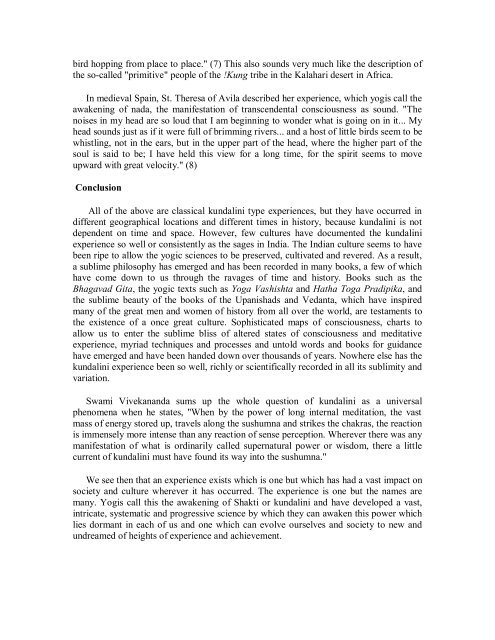Kundalini.Tantra.by.Satyananda.Saraswati
You also want an ePaper? Increase the reach of your titles
YUMPU automatically turns print PDFs into web optimized ePapers that Google loves.
ird hopping from place to place." (7) This also sounds very much like the description of<br />
the so-called "primitive" people of the !Kung tribe in the Kalahari desert in Africa.<br />
In medieval Spain, St. Theresa of Avila described her experience, which yogis call the<br />
awakening of nada, the manifestation of transcendental consciousness as sound. "The<br />
noises in my head are so loud that I am beginning to wonder what is going on in it... My<br />
head sounds just as if it were full of brimming rivers... and a host of little birds seem to be<br />
whistling, not in the ears, but in the upper part of the head, where the higher part of the<br />
soul is said to be; I have held this view for a long time, for the spirit seems to move<br />
upward with great velocity." (8)<br />
Conclusion<br />
All of the above are classical kundalini type experiences, but they have occurred in<br />
different geographical locations and different times in history, because kundalini is not<br />
dependent on time and space. However, few cultures have documented the kundalini<br />
experience so well or consistently as the sages in India. The Indian culture seems to have<br />
been ripe to allow the yogic sciences to be preserved, cultivated and revered. As a result,<br />
a sublime philosophy has emerged and has been recorded in many books, a few of which<br />
have come down to us through the ravages of time and history. Books such as the<br />
Bhagavad Gita, the yogic texts such as Yoga Vashishta and Hatha Toga Pradipika, and<br />
the sublime beauty of the books of the Upanishads and Vedanta, which have inspired<br />
many of the great men and women of history from all over the world, are testaments to<br />
the existence of a once great culture. Sophisticated maps of consciousness, charts to<br />
allow us to enter the sublime bliss of altered states of consciousness and meditative<br />
experience, myriad techniques and processes and untold words and books for guidance<br />
have emerged and have been handed down over thousands of years. Nowhere else has the<br />
kundalini experience been so well, richly or scientifically recorded in all its sublimity and<br />
variation.<br />
Swami Vivekananda sums up the whole question of kundalini as a universal<br />
phenomena when he states, "When <strong>by</strong> the power of long internal meditation, the vast<br />
mass of energy stored up, travels along the sushumna and strikes the chakras, the reaction<br />
is immensely more intense than any reaction of sense perception. Wherever there was any<br />
manifestation of what is ordinarily called supernatural power or wisdom, there a little<br />
current of kundalini must have found its way into the sushumna."<br />
We see then that an experience exists which is one but which has had a vast impact on<br />
society and culture wherever it has occurred. The experience is one but the names are<br />
many. Yogis call this the awakening of Shakti or kundalini and have developed a vast,<br />
intricate, systematic and progressive science <strong>by</strong> which they can awaken this power which<br />
lies dormant in each of us and one which can evolve ourselves and society to new and<br />
undreamed of heights of experience and achievement.














![[Lonely Planet] Sri Lanka](https://img.yumpu.com/59845622/1/169x260/lonely-planet-sri-lanka.jpg?quality=85)


